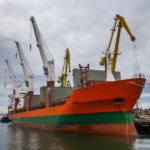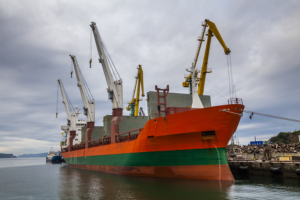1 – What is a TEU?
TEU is a size measure used in maritime transportation and stands for a twenty-foot equivalent unit, a standard that can be useful to measure a ship’s cargo capacity. To clarify, one TEU is 20 feet long and 8 feet tall.
Ports and ships around the world get their measures through their TEU volume, this metric is a worldwide standard. The largest port in the world, Shanghai, China, handled around 43.5 million TEUs in 2020. This is more than the combined capacity of the 4 major US gateways, which total is 32.9 million TEUs.
2- How many ports are there in Latin America?
In total, 31 countries have 118 operating ports. The five main ones are:
1. Itaqui, Brazil
Located in the city of Sao Luis, the port of Itaqui ships 146 million tons of cargo per year. Its facilities include a 1,616 m long wharf, six berths, three reach stackers for container handling, two ship loaders, and twenty stackers. Over the last few years, it has doubled the volume of containers and tripled the total number of tons it handles.
2. Tubarão, Brazil
Located near the town of Vitoria, the port of Tubarão is the world’s largest iron ore embarking port, moving 80 million tons of it per year. Therefore, it is crucial for exporting Brazilian iron ore extracted from the nearby mines in Minas Gerais.
3. Santos, Brazil
Located in the city of Santos and 70 miles from Brazil’s most populous city, Sao Paulo, the port of Santos has the largest logistics capacity in Latin America and is Brazil’s most modern port. So, in 2018, it processed 133 million tons of cargo, generating $250 million in revenue. From 2006 until recently, it was the busiest port in Brazil.
4. Callao, Peru
Located in the Lima-Callao metropolitan area, the port of Callao handles 43 million tons of cargo per year. As Peru’s biggest and most important port, it is a vital component of the country’s commercial network and a major distribution center for imports and exports. The Port of Callao handles about 20% of Peru’s ocean-borne cargo.
5. Cartagena, Colombia
Located in the city of Cartagena on the Caribbean Sea and 265 nautical miles from the Panama Canal, the port of Cartagena ships 33 million tons of cargo volume every year. One of its sea terminals, Sociedad Portuaria Regional de Cartagena, has been named “Best Caribbean Port” 7 times between 2005 and 2015 and was called “most reliable port” in 2013 by the Caribbean Shipping Association for its high levels of productivity and efficiency.
Where in the world do containerized goods come from?
1) China – US$ 2.654 trillion
Above all, China is the largest exporting country in the world. With the US in second place. China is also famous for being the manufacturing center for technology products. The high supply and low labor costs provide a competitive advantage in the international market.
2) United States – US$ 1.803 trillion
The United States comes in second place and is one of the largest economies in the world. Likewise, the USA has many natural resources that contribute to improving its exports. In addition, this powerful country has the likes of some of the largest companies in the world, such as Google, Facebook, Microsoft, and Apple.
3) Germany – US$ 1.432 Trillion
Germany has been experiencing growth for about a decade. Furthermore, looking at their latest recorded export sales of $1,432.7 Trillion, they seem unwilling to slow down. Germany is also known as one of the largest manufacturers of luxury cars. Their vehicles hold a 19% discount on all the exports they make. The country exports products such as electronic products, motor vehicles, chemical products, and machinery, among others.
How much weight does maritime transportation handle each year?
Some 11 billion tons of goods are transported by ship each year. To clarify, this represents an impressive 1.5 tons per person based on the current global population. 80% of the world’s trade is transported by sea.
How much does Latin America participate in maritime transportation?
The total value of exports in Latin America is US$ 998,109 million. While the total value of imports is US$ 980,570 million. In other words, 4,520 products are exported to 230 countries, and 4,629 products are imported from 237 countries.
However, Latin America and the Caribbean accounted for about 17% of the world’s total maritime cargo. Nonetheless, the regional share in the maritime transport industry is smaller. Even though most of Latin America’s largest countries had their own shipping companies.
Information in the palm of your hand
To sum up, global maritime transportation is full of details and is constantly facing transformations, as well as being responsible for a large part of the supply chain. Get a smart operating system capable of collecting and analyzing all global maritime transport data, click here.


















